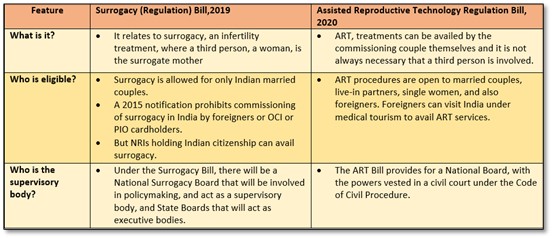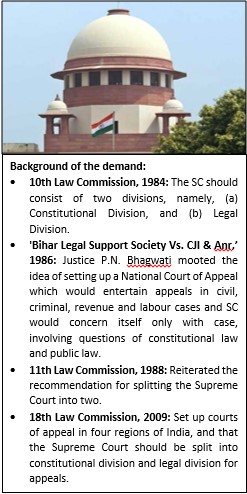Monday, 6th December 2021
MPs’ Questions in the Parliament
In News
Recently, a question by a MP in Rajya Sabha that was scheduled to be answered was removed from the list of finally admitted questions.
Procedure for admitting the questions in the Parliament
- Form of Questions: In both Houses, elected members enjoy the right to seek information from various ministries and departments in the form of starred questions, unstarred questions, short notice questions and questions to private members.
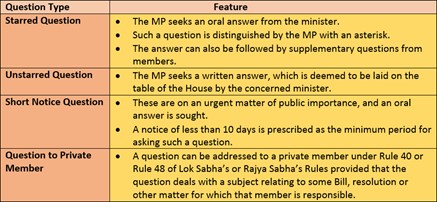
- Question to Private Member: The admissibility of questions in Rajya Sabha is governed by Rules of Procedure and Conduct of Business in the Council of States.
- In Lok Sabha, once the notice for questions is received, ballots determine priority. Questions are examined for admissibility under the Rules of Procedure and Conduct of Business in Lok Sabha.
- Grouping of Ministries for answering: For answering the questions, ministries and departments have been divided into five groups in such a way that each minister has one fixed day in the week for answering questions in Rajya Sabha and another fixed day for answering questions in Lok Sabha.
- When are the questions asked? In both Houses, the first hour of every sitting is devoted to asking and answering of questions referred to as the ‘Question Hour’. The total number of questions for any day is limited to 175.
- Nature of questions asked: The Chairman or the Speaker has the authority to decide whether a question or a part is or is not admissible under the norms of the House.
- In Rajya Sabha, the question shall be specific and confined to one issue only and it shall not bring in any name or statement not strictly necessary to make the question intelligible.
- In Lok Sabha, questions that are not admitted include those that are repetitive or have been answered previously; and matters that are pending for judgment before any court of law or under consideration before a Parliamentary Committee.
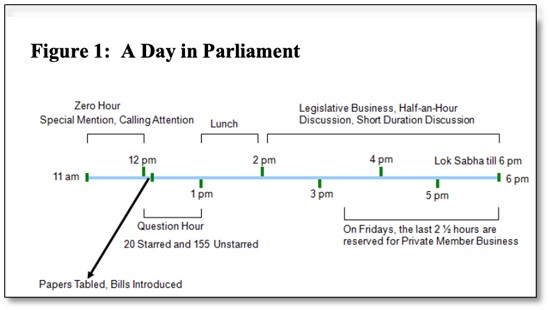
Where can it be used?
- Parliamentary Questions, Rules of the House, Question Hour
Source:
- Explained: How MPs’ questions are allowed, disallowed
- Disallowing an MP's Question in Rajya Sabha Will Devalue Parliament
Image Source:
PepsiCo loses licence to grow potato variety
In News
PepsiCo India has lost the rights to its FC5 potato variety, grown exclusively for its popular Lay’s potato chips.
A brief history
- The FL-2027 variety of potato (commercial name FC-5), first cultivated in 1987, has 5 per cent lower moisture content than other varieties. It is considered more suitable for processing and thus, for making snacks such as potato chips.
- Introduced to India in 2009, the potato was grown by about 12,000 farmers in Punjab with whom the company had an exclusive contract to sell seeds and buy back their produce.
- PepsiCo applied for registration of the potato variety under the Protection of Plant Varieties and Farmers Rights’ Authority (PPV&FRA) in India in June 2011, which was granted in 2016.
PepsiCo vs Farmers, 2019
- In April 2019, PepsiCo sued nine Gujarat farmers for cultivating the same potato variety, accusing them of infringing its intellectual property rights (IPR).
- It sought over Rs 1 crore each from the farmers for alleged patent infringement under the PPV&FR Act, 2001.
- PepsiCo soon withdrew the suit following a backlash from farmers as the variety was registered as an ‘extant variety’ in India, implying that the said variety of potato was already available in the country before it was registered.
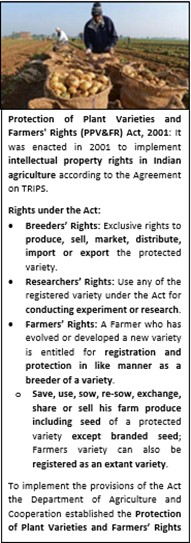
Kavitha Kuruganti vs PepsiCo, 2019
- Kavitha Kuruganti, convenor of the Alliance for Sustainable and Holistic Agriculture, filed an application for revocation of the certification for the registered potato variety in June 2019.
- Hence, an order was passed by the Protection of Plant Varieties and Farmers’ Rights Authority (PPVFRA) revoking a PVP (plant variety protection) certificate granted to PepsiCo (India) Holdings Pvt. Ltd for the potato variety. The authority has observed the following:
- Several farmers have been put to hardship including the looming possibility of having to pay huge penalty on the purported infringement which did not eventually happen as on date. This violates public interest.
- The Registrar in this case had been superficial by only cursorily glancing through information documentation. There were discrepancies in the date of first sale of the variety, as disclosed by PepsiCo, and several documents hadn’t been submitted at the time of registration.
Where can it be used?
- PepsiCo, Plant Varieties and Farmers Rights’ Authority (PPV&FRA), Patent Issues
Sources:
National strategy on blockchain
In News
The Ministry of Electronics and Information Technology (MeitY) has recently released a “National strategy on blockchain”.
Important Features of the report
The proposed National Blockchain Framework (NBF) will have three types of participants- confident user of technology (application developers), provider or operator of technology (infrastructure and services, Blockchain as a service), and complete technology stack builder (IP creator).
- It will be a multi-institutional model with each organisation have defined roles and responsibilities.
- To develop collaborative frameworks with other ministries/ departments and states
- Involvement of innovative startups and industry to bring in the agility to the infrastructure.
- Creation of a dedicated team to hand-hold the implementers at various central / state government applications.
- The sectors, where blockchain models have applications, have been identified as education, governance, finance & banking, healthcare, logistics, cyber security, media, legal, power sector, etc.
Why is Blockchain framework important?
- The potential of the use of blockchain, which is expected to reach business value of $176 billion by 2025 and $1.3 trillion by 2030.
- Blockchain technology provides a platform for future economic development and possible growth that is worthy of valuation.
- By 2022, many new innovative companies will start using Blockchain technology and at least one business created using Blockchain technology will be worth $10 billion.
- By 2030, Blockchain would be used as a foundational technology for 30% of the global customer base that will be made up of things, and these things will be used for conducting commercial activities.
Major Challenges
- Technology Adoption: With plethora of Blockchain platforms being developed, a careful analysis of return on investment, governance, security & privacy and throughput has to be taken into consideration while understanding suitability of Blockchain in an application context.
- Regulatory Compliance: While advocating the usage of Blockchain for an application domain, it is important to study compliance to applicable regulatory provisions and their implications, if any, with respect to the chosen application domain. Based on the requirements, additional regulatory policies may be evolved.
- Identification of Suitable Use Cases: Different applications have different levels of security, privacy and data storage requirements depending on the number of participating entities and hence suitability of Blockchain in a particular application context needs to be analysed carefully.
- Data Format: The success of utilizing Blockchain capabilities depends on how well the transaction data format has been defined in a multi-party environment and keenly observing its related characteristics such as its dependency on other information.
- Awareness and Skill Set: Availability of skilled manpower who understands Blockchain potential and its applicability to a particular application domain is required for successful implementation of the technology.
What is Blockchain technology?
Blockchain technology works on the concept of a digitally distributed ledger connected across networks of computers. It is a system of recording information in a way that makes it difficult or impossible to change, hack, or cheat the system.
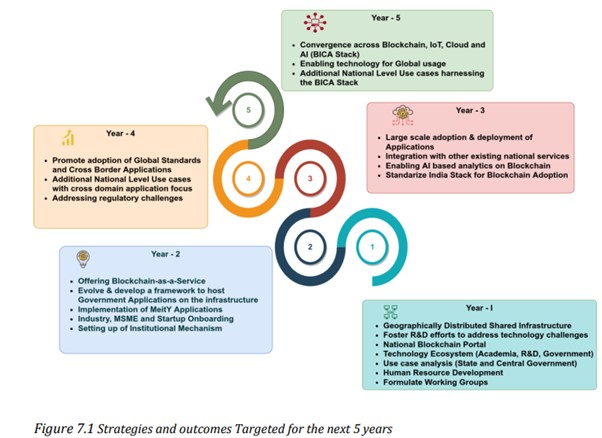
Where can it be used?
- Blockchain technology, National blockchain strategy
Sources:
Mahaparinirvan Diwas - Edukemy Current Affairs
On December 6, 1956, Dr Bhimrao Ramji Ambedkar breathed his last while in his sleep and the day is regarded as Mahaparinirvan Diwas to pay tribute to him. In Buddhism, ‘parinirvana’ which means nirvana-after-death occurs upon the death of someone who has attained nirvana during their lifetime. It implies a release from the world, karma and rebirth as well as the dissolution of the skandhas. He was primarily an Economist and educationist. Babasaheb was also the flag bearer of India’s Dalit Activism, is called the chief architect of the Indian Constitution. He was also the law minister of India after independence. He had also started fortnightly and weekly papers named ‘Excluded India’, ‘Mook Nayak’, ‘Janta’ to raise voice against the atrocities on Dalits. Ambedkar was posthumously conferred with the Bharat Ratna.
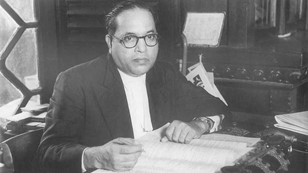
Source:
Weaponisation of Trade
In News
Australia’s special envoy to India has accused China of ‘trade weaponisation’.
The Concept of Weaponisation of Trade
- The concept of weaponization of trade is one in which trade is used as a tool of coercion to achieve strategic influence, and trade becomes an instrument of foreign policy.
- In the context of China, the Chinese government encourages and exploits states’ economic reliance on it to compel their support for its foreign policy objectives. It even uses economic punishments in the form of restricting imports of boycotting goods from targeted countries.
- Examples: China’s blockage of exports of strategically important rare earth minerals to Japan in 2010 over a diplomatic spat over the Senkaku Islands, the imposition of punitive fees on Mongolia in 2016 for its commodity exports for hosting Dalai Lama, blocking coal imports from Australia.

Comparative Advantage versus Strategic Trade
- The modern understanding of international trade, facilitated by the flows of globalization is largely based on the principle of comparative advantage.
- Governments raise national income at other countries expenses by supporting national firms in international competition. This new trade theory came to be known as the strategic trade theory.
- This has been the exact model behind China’s export-led growth strategy. As seen in the Non Tariff Barriers (NTBs) that are faced by Indian products for example or even the subsidies provided to Chinese firms by the Chinese government, China has indeed turned a trade into the strategic trade.
- The subsidies provided by the Chinese government enabled firms to engage in manufacturing at massive scales, leading to an oversupply of goods in turn-which was then exported to other countries, including the South Asian ones.
From Strategic Trade to Weaponisation of Trade
- The concepts of strategic trade and the weaponization of trade are closely related. Only after trade can be established as strategic trade, can it be used as a tool of foreign policy to penalize states economically, leading to what is the weaponization of trade.
- While trade and foreign policy have been closely intertwined throughout history, the danger today is that the fragile equilibrium between economics and politics tips too far in favour of the latter. Taken to an extreme, trade wars are both an objective of policy to protect national interests and a means of achieving foreign policy goals — as with Brexit and North Korea.
- As seen in the case of China’s trade with South Asia, and the dependence it has created, in the near future, a weaponization of trade, wherein China can use its economic leverage to gain strategic leverage in South Asia is not difficult to imagine.
What drives countries to adopt protectionist policies?
Although international trade offers mutual benefits and opportunities for economic growth, it is nearly impossible to disentangle the political implications of trade policy.
Key reasons for protectionist behavior leading to trade weaponisation are –

Greater resource security brings greater geopolitical leverage
By diversifying its natural resource suppliers, China is increasingly reducing a key vulnerability and strengthening its geopolitical levers. Beijing sees three areas in particular that shift the balance in its favour.
- Beijing will use trade as a coercive weapon: Through measures such as import restrictions, China is in a better position to use its massive market as diplomatic leverage in great power competition.
- Closer China-Russia ties will act as a counterbalance to the West: Deteriorating relationships with the West have driven the two countries to cooperate closer in multiple areas, in particular energy. Increasing energy imports from Russia will further both Beijing’s import diversification strategy and Moscow’s ’Pivot to Asia’.
- China-backed multilateral initiatives will favour Belt and Road partners: Beijing’s diversification strategy will increase Chinese investment in and trade with selected countries, mostly its Belt and Road Initiative partners, which will in turn increase their economic reliance on China. These partnerships will reshape multilateralism with a China-centric economic order.
China using Trade as Weapon against India
China is one of India’s largest trading partners, with India’s annual imports from China aggregating to about $75 billion, while India’s exports to China barely touch $15 billion. The annual trade deficit with China, at $60 billion, is the largest that we have with any of trading partners in the world.
China uses Trade as a weapon against India in following ways:
- Targeting Indian local industries: Chinese firms, with a great deal of coordination with & support from its Government, have systematically targeted Indian local manufacturing industries like power plants & equipment, pharmaceutical firms manufacturing API molecules and the unorganized sector in such low value added stuff like aggarbattis, plastic toys, T-shirts etc. with predatory pricing attacks.
- Debilitating Indian Exports: China has added another thread to its strategy of debilitating Indian exports by offering zero-duty access to exports from our neighbours such as Pakistan while Indian goods are subjected to normal duties. E.g., Pakistani cotton yarn enters the Chinese market at zero duty while Indian yarn is shut out on grounds of price because of higher duty.
- Even in products in which India has a comparative advantage, there exists tariff as well as non-tariff barriers (NTBs) for them in China. It takes about five to six years for even the longest established Indian Pharma firms to register their products in China.
- Importing from other countries at cost of India: By diverting imports from India to Pakistan, China transfers wealth to Pakistan from India at no cost to itself, building its clout in Pakistan, and reducing India’s influence in the neighbourhood.
- Encircling India: China’s debt trap diplomacy and assertive takeover of strategic ports in India’s neighborhood (e.g., Hambantota port in Sri Lanka) further affects India’s security concerns.
Conclusion: China already has gained the control of the strategic Hambantota port in Sri Lanka through its debt trap diplomacy, and even though Sri Lanka has stated that it will not allow it to be used for military purposes, in all probability, given that strategic trade has already been established by China; and Sri Lanka is dependent on China for a plethora of goods, a weaponisation of trade is possible in the near future. A similarity is seen in Pakistan’s Gwadar port which has been leased to a Chinese company for 40 years. The same is the case with the other South Asian countries which hampers the prospects of India as a regional power. India must make efforts in the region to convince the countries in South Asia to reverse the trend from being one of strategic trade to trade based on comparative advantage, so as to avoid an inevitable utilization by China of bilateral trade to suit its own strategic interests.
Question: Discuss the idea of Weaponisation of Trade with examples.
Where can it be used?
- IR, Trade wars, GS paper 2, India-China relations
Source:
- From Strategic Trade to Weaponization of Trade
- China’s Weaponization of Trade
- Australia’s special envoy to India accuses China of ‘trade weaponisation’
- The Weaponization of Trade: A study of modern trade conflicts from the mid-1900s to present
- ‘Trade has been weaponised — India should lift tariffs on America’s Harley-Davidson bikes’
- India fires a salvo at China
- China’s weaponization of trade
- Weaponising Trade
- Trade as a Weapon of War
- Trade as a weapon or as a boomerang?
- China's resource security redrawing geopolitical map
- China outwits a too clever-by-half Modi, uses trade as weapon to weaken Indian exports and industry
Chewing gum to reduce Covid-19 transmission
New experimental chewing gum has been developed that can reduce the transmission of coronavirus. Chewing gum containing a protein that traps coronavirus particles could limit the amount of virus in saliva and help curb the Covid transmission. Evidence shows that people infected with SARS-CoV-2 have high levels of virus in their saliva. The SARS-CoV-2 gains entry into human cells by latching onto ACE2 proteins which are found on the surfaces of certain cells in our body. Therefore, the researchers have created a chewing gum that contains a copy of ACE2 protein. Chewing gum to promote oral health is not a new idea. Studies have shown that chewing gums containing certain substances such as calcium and bicarbonate can help in reducing dental ailments.

Source:
Programme to Upskill Street Food Vendors
- Context: The ministry of skill development and entrepreneurship (MSDE) has launched a programme to upskill street food vendors.
- India has 5 million street food vendors and their contribution to the informal economy is 14%.
- Under the project, skills training will be imparted to the street food vendors and make them eligible for e-cart licenses while improving the hygiene conditions in food preparation and aesthetics of vending.
- They are educated on health and safety standards, safety provisions under COVID-19 protocols, effective communication techniques with staff and customers, new-age skills such as digital and financial literacy, digital payments and e-selling.
- The vendors will also be supported with loans under the Mudra Scheme.
- This will lead towards better services to consumers, more opportunities to vendors for revenue generation, awareness on regulations and stipulated rules and better services to the local bodies.
- The project will be implemented under the ‘Recognition of Prior Learning (RPL)’ component of the Central Government’s skill development initiative -the Pradhan Mantri Kaushal Vikas Yojana (PMKVY) 3.0.
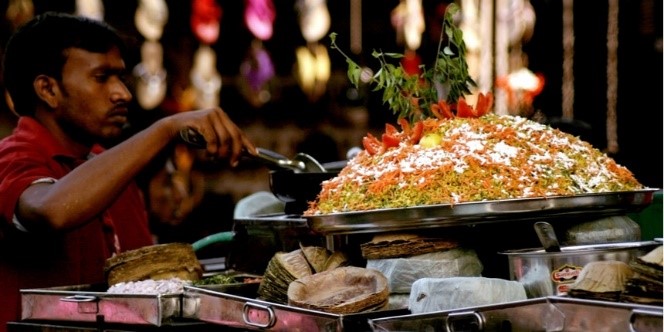
Source:
- Skill India launches programme to upskill street food vendors
- Programme launched to upskill street food vendors
Image Source:
Paika Rebellion
- Context: The Centre has recently said in the Parliament that it will not recognise the Paika rebellion as the first War of Independence.
- The Paika Bidroha (Paika Rebellion) was an armed rebellion that took place in 1817 (nearly 40 years before the first sepoy mutiny).
- The Paikas were peasant militas of the Gajapati rulers of Odisha who offered military services to the king.
- They lost their estates when the new colonial establishments and land revenue settlements of the British came into force (British established themselves in Odisha when the EIC dethroned the King of Khurda, Raja Mukunda Deva in 1803).
- The British’s continuous interference in the economy and revenue systems led to exploitation and oppression of the peasants and farmers eventually triggering a rebellion against them.
- A large number of Paikas were mobilised under the leadership of Bakshi Jagabandhu Bidyadhar, 1817. The uprising spread like a wildfire across the state resulting in several confrontations and encounters between the British and the Paika forces.
- Government buildings in Banapur were set on fire, policemen killed and the British treasury looted.
- Over the next few months, the revolt continued but was eventually overpowered by the British army. Bidyadhar was imprisoned in 1825 and died while still in jail four years later.
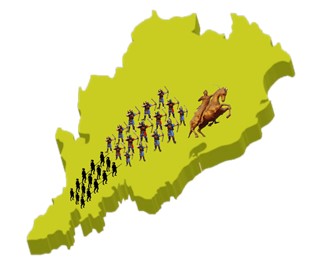
Source:
- Explained: Why Centre has refused to accept Paika revolution as first war of independence
- Paika rebellion to be included as ‘case study’ in history textbook: Minister
Image Source:
SPPEL Scheme
- Context: The Government of India has initiated a Scheme known as “Scheme for Protection and Preservation of Endangered Languages of India” (SPPEL).
- Under this Scheme, the Central Institute of Indian Languages (CIIL) works on protection, preservation and documentation of all the mother tongues/languages of India spoken by less than 10,000 people which are called endangered languages.
- In the first phase of the scheme, 117 endangered languages/mother tongues have been chosen from all over India for study and documentation on a priority basis.
- The University Grants Commission (UGC) has also initiated two schemes for protection of endangered languages, namely:
- ‘Funding Support to the State Universities for Study and Research in Indigenous and Endangered languages in India’ and
- ‘Establishment of Centres for Endangered Languages in Central Universities’.
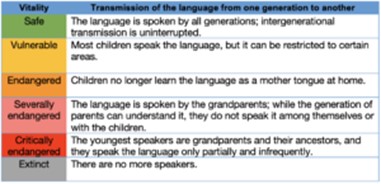
Source:
Landslide Early Warning System (LEWS)
- Context: Geological Survey of India (GSI), Ministry of Mines has developed a prototype regional Landslide Early Warning System (LEWS) for India.
- GSI through the LANDSLIP project (www.landslip.org) is engaged in developing an experimental regional Landslide Early Warning System (LEWS) based on rainfall thresholds since 2017.
- The LANDSLIP research has developed a prototype model in 2020 based on the terrain-specific rainfall thresholds for two test areas (Darjeeling district, West Bengal, and the Nilgiris district, Tamil Nadu).
- Full form of LANDSLIP: Landslide multi-hazard risk assessment, preparedness and early warning in South Asia integrating meteorology, landscape and society
- In India, about 0.42 million sq. km or 12.6% of land area, excluding snow covered area, is prone to landslide hazard.

Source:
Image Source:
The way forward in US-India economic ties: ET
Essence: The article highlights the need for strong India-US bilateral trade and investment pact in order to develop alternative supply chains that avoid dependence on China. Despite being 9th largest trade partner in the goods for US and US being the fifth largest source of FDI in India, the current level of economic engagement falls behind the potential.
One of the many reasons being withdrawal of trade preferences given to India under the GSP program along with removal of India from the US’s list of ‘developing countries’. US also claims that its exports face a number of tariff and non-tariff barriers in India along with weak intellectual property protection. The relaunching of India- US trade forum provides a great platform to revamp the ties between the two countries with a driving factor to counter the Chinese threat globally.
Why you should read this article?
- To understand the status of trade between India and US.
- To understand the key areas which are acting as detrimental factors in realizing the full potential of India-US trade ties.
- To understand why it is necessary to reinvigorate the relationship between India and USA.
- The article comprehensively provides points to supplement the notes on Indo-US relationship (GS-2, International Relations)
Sources:
The need to reopen Anganwadi: TH
Essence: As a part of Integrated Child Development Services (ICDS), Anganwadis play an important role in supporting household, particularly from low-income families, by providing childcare, health and nutrition, education etc. The New Education Policy, places Anganwadis at the centre of Early Childhood Care and Education (ECCE) policy. The closure due to lockdown significantly affected their service delivery. Now, when the Anganwadis are slowly reopening, it is important to realize that what crucial support they provide to the society and at the same time to understand that there is a need to provide solutions to the challenges they face.
According to some surveys, Anganwadi workers lack knowledge about key health behaviours like handwashing and breastfeeding, Anganwadis often lack infrastructure etc. According to NFHS 4 the utilisation of early childcare services at Anganwadis at only 28 percent as compared to 42 percent in rural areas. It is important to improve their outcomes by large scale enrolment drives (like in Gujarat), hire more additional workers to improve career incentives (like in Tamil Nadu). It is important for India to invest robustly in the world’s largest programme on early childhood services.
Why to read this article?
- To understand why it is important to reopen Anganwadis and why does India need to invest robustly in them.
- To realize the importance, challenges and solutions related to Anganwadi.
- To note some best Anganwadi initiatives and other examples from various states and evaluate them.
Source:
A man leading a menstrual hygiene drive
Background
- Menstruation is still considered as a taboo in the Indian society, leading to restrictions and isolations of females.
- Adolescent girls in the poorer strata of the society are the major victims as of the stigma and lack of awareness of menstruation hygiene.
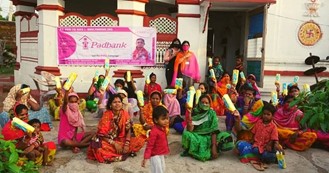
Story of a man who led a movement for better menstrual hygiene
- Arun Gupta, a resident of Delhi was surprised to know about the menstrual hygiene issues faced by a maid’s daughter.
- Having learnt about the meagre availability of sanitary napkins by this girl, he understood the urgency to literate people about menstrual hygiene.
- Initially, he started with donating sanitary napkins with his daughter to the girls of poor section of the society around his area.
- Later they started an NGO Pinkishe Foundation and used social media platforms to spread awareness about the issue.
- Now, they are a society of 2 lakh members, with people participating from all over India, along with members from Canada, and the US.
- The NGO runs awareness programme, distribution of sanitary kits, educating boys in school about menstrual health and hygiene.
Quote:
“Menstruation is not a problem, poor menstrual hygiene is” ― Anurag Chauhan
Where can it be used:
Paper 1: Indian Society and its issues, women
Paper 3: Health
Paper 4: Compassion and dedication.
Source:
Share the article
Get Latest Updates on Offers, Event dates, and free Mentorship sessions.

Get in touch with our Expert Academic Counsellors 👋
FAQs
UPSC Daily Current Affairs focuses on learning current events on a daily basis. An aspirant needs to study regular and updated information about current events, news, and relevant topics that are important for UPSC aspirants. It covers national and international affairs, government policies, socio-economic issues, science and technology advancements, and more.
UPSC Daily Current Affairs provides aspirants with a concise and comprehensive overview of the latest happenings and developments across various fields. It helps aspirants stay updated with current affairs and provides them with valuable insights and analysis, which are essential for answering questions in the UPSC examinations. It enhances their knowledge, analytical skills, and ability to connect current affairs with the UPSC syllabus.
UPSC Daily Current Affairs covers a wide range of topics, including politics, economics, science and technology, environment, social issues, governance, international relations, and more. It offers news summaries, in-depth analyses, editorials, opinion pieces, and relevant study materials. It also provides practice questions and quizzes to help aspirants test their understanding of current affairs.
Edukemy's UPSC Daily Current Affairs can be accessed through:
- UPSC Daily Current Affairs can be accessed through Current Affairs tab at the top of the Main Page of Edukemy.
- Edukemy Mobile app: The Daily Current Affairs can also be access through Edukemy Mobile App.
- Social media: Follow Edukemy’s official social media accounts or pages that provide UPSC Daily Current Affairs updates, including Facebook, Twitter, or Telegram channels.

